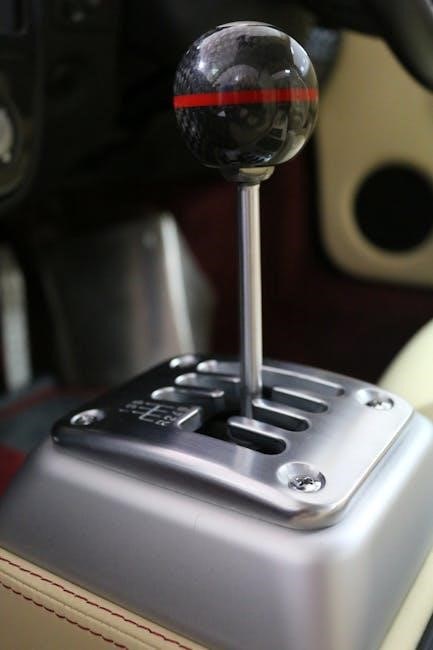
A manual transmission can become stuck in gear due to worn components, low fluid levels, or internal damage. This issue causes frustration and requires immediate attention to prevent further damage to the vehicle.
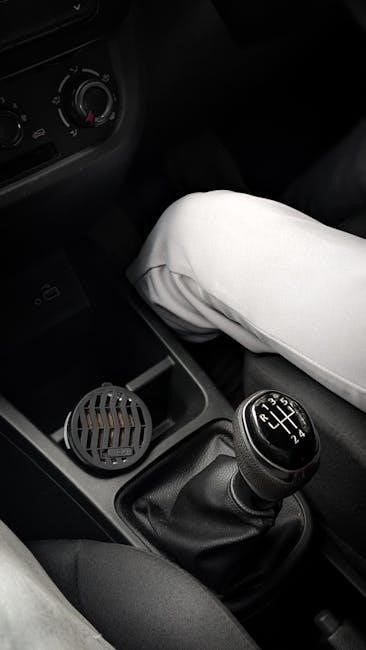
Causes of Manual Transmission Stuck in Gear
Worn synchronizers, low transmission fluid, and a faulty clutch are common causes. Extreme temperatures and internal damage can also lead to gears sticking, disrupting smooth operation and requiring prompt repair.
Worn Synchronizers
Worn synchronizers are a leading cause of a manual transmission getting stuck in gear. Synchronizers are critical components that ensure smooth gear transitions by equalizing the speed of moving parts. Over time, they can wear down due to constant friction and heat, especially in high-mileage vehicles. When synchronizers degrade, they fail to engage gears properly, leading to difficulty shifting or gears becoming stuck. For example, if the synchronizer rings are worn, the transmission may struggle to disengage from one gear before engaging the next, causing the gear to remain in place. This issue is often exacerbated by aggressive driving or frequent quick shifts, which accelerate wear; Symptoms of worn synchronizers include grinding noises during shifts and resistance when attempting to change gears. If left unaddressed, this can lead to more severe internal damage, requiring costly repairs. Regular maintenance and inspection of synchronizers are essential to prevent this issue.
Low Transmission Fluid
Low transmission fluid is another common reason for a manual transmission getting stuck in gear. Transmission fluid lubricates the gears and synchronizers, ensuring smooth operation. When fluid levels drop due to leaks or wear, the gears and synchronizers can overheat and fail to engage properly. This often results in gears becoming stuck or difficult to shift. For instance, if the fluid level is too low, the synchronizers may not have enough lubrication to function correctly, causing the transmission to lock up. Symptoms of low transmission fluid include difficulty shifting, grinding noises, and a balky gearshift. It is essential to check and top up the transmission fluid regularly, as severe fluid depletion can lead to permanent damage. Addressing this issue early can prevent costly repairs and keep the transmission running smoothly. Always refer to the vehicle’s manual for the correct fluid type and filling procedure. Regular maintenance is key to avoiding this problem.
Faulty Clutch Mechanism
A faulty clutch mechanism is another common cause of a manual transmission getting stuck in gear. The clutch is responsible for disconnecting the engine’s power from the transmission when changing gears. If the clutch fails to disengage properly, the gears cannot shift smoothly, leading to the transmission becoming stuck. This issue can manifest as difficulty shifting into gear or the transmission remaining in a gear even after attempting to shift. Common problems include a worn clutch plate, faulty clutch master or slave cylinders, or misaligned clutch components. Over time, these issues can cause the clutch to malfunction, making it hard to change gears. Addressing a faulty clutch mechanism promptly is crucial to prevent further damage to the transmission. Regular inspection and maintenance of the clutch system can help identify and resolve issues before they escalate. A malfunctioning clutch not only affects gear shifts but also overall vehicle performance.
Extreme Temperatures
Extreme temperatures can significantly impact the performance of a manual transmission, potentially causing it to become stuck in gear. High temperatures can lead to the degradation of transmission fluid, reducing its lubricating properties and causing components like synchronizers and gears to wear down faster; This wear can result in gears not disengaging properly, leading to the transmission becoming stuck. Conversely, extremely cold temperatures can cause the transmission fluid to thicken, slowing down the flow of fluid and delaying pressure buildup in the clutch packs. This delay can make shifting gears difficult, increasing the likelihood of the transmission getting stuck. Additionally, cold weather can cause metal components to contract slightly, potentially misaligning critical parts and further complicating gear shifts. Both high and low temperatures can exacerbate existing issues, such as worn components or low fluid levels, making the problem more pronounced. Regular fluid checks and proper maintenance are essential to mitigate these effects.
Internal Transmission Damage
Internal transmission damage is a serious issue that can cause gears to become stuck. Over time, components like gears, bearings, and shafts can wear out or break, leading to mechanical failure. If a gear tooth breaks, it can prevent the gear from disengaging properly, causing the transmission to lock in place. Similarly, damaged synchronizers or clutch packs can fail to engage or disengage gears smoothly, resulting in a stuck gear. High mileage and lack of maintenance often contribute to this problem. In some cases, internal damage may require extensive repairs, such as rebuilding or replacing the entire transmission. Symptoms of internal damage include unusual noises, vibrations, or resistance when shifting gears. If left unaddressed, this issue can lead to complete transmission failure, leaving the vehicle inoperable. Professional diagnosis is usually necessary to identify the extent of the damage and determine the appropriate repair. Prompt action is crucial to avoid further complications.

Symptoms of a Stuck Gear
Common symptoms include gears sticking in position, difficulty shifting, unusual noises, and getting stuck in neutral. These issues can arise from worn components or internal damage, requiring prompt attention.
Gear Stuck in Position
One of the most common symptoms of a manual transmission issue is when a gear becomes stuck in a specific position. This can happen unexpectedly, leaving the driver unable to shift into another gear or even into neutral. For instance, the transmission might remain stuck in sixth gear, as reported by some Chrysler Crossfire owners, or in first gear, as noted in older Ford Mustang models. This problem often occurs due to worn synchronizers or internal damage, which prevent the gear from disengaging properly. Drivers may find themselves unable to accelerate or decelerate smoothly, making it difficult to control the vehicle. In some cases, the gear may stay stuck even after repeated attempts to shift, signaling a serious underlying issue that requires professional attention. This symptom is a clear indicator that the transmission is not functioning as it should, and immediate inspection is necessary to avoid further damage.
Difficulty Shifting Gears
Difficulty shifting gears is a common symptom of a manual transmission issue, often preceding a gear becoming stuck. Drivers may experience resistance or hesitation when trying to move the shift lever, making it hard to engage the desired gear. This problem can stem from worn synchronizers, which are critical for smooth gear transitions. Low transmission fluid levels or degraded fluid can also cause shifting difficulties, as the hydraulic system relies on proper lubrication to function. Additionally, a faulty clutch mechanism or misaligned shift cables can contribute to the problem. For example, a Honda CR-V owner reported that despite repairing the clutch and transmission, the issue persisted, indicating a potential problem with the shift mechanism. Such difficulties can lead to a complete gear lock, leaving the driver stranded. Addressing shifting problems early is crucial to prevent the transmission from becoming stuck in a gear entirely.
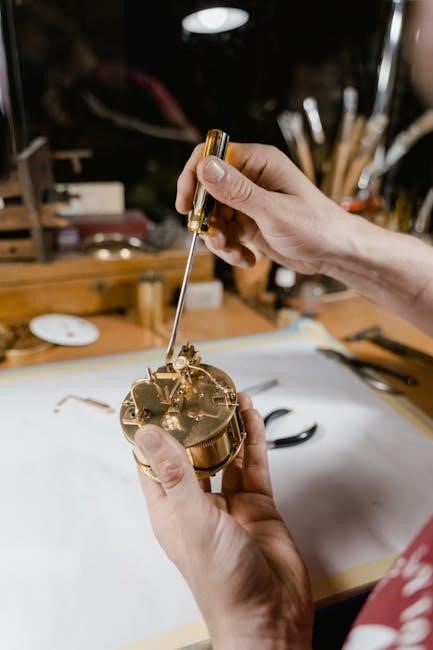
Unusual Noises
Unusual noises, such as grinding, clunking, or whining sounds, often accompany a stuck gear in a manual transmission. These noises can indicate internal damage or misalignment within the gearbox. For instance, worn synchronizers may produce a grinding sound when attempting to shift gears, as they fail to properly engage the gear teeth. Similarly, damaged bearings or gears can create clunking noises, especially when the transmission is under load. In some cases, the sound may vary depending on the gear position or the driver’s attempt to shift. A Ford Mustang owner reported hearing unusual noises before the transmission became stuck in gear, highlighting how these sounds can serve as early warning signs. Ignoring such noises can exacerbate the issue, potentially leading to complete gear lock. Addressing the root cause promptly is essential to prevent further damage and costly repairs. These audible cues are critical for diagnosing the problem accurately.
Stuck in Neutral
Another common issue is when a manual transmission becomes stuck in neutral, making it impossible to engage any gear. This can happen due to internal damage or failure of critical components like the shift mechanism or transmission bearings. In some cases, such as a Nissan Sentra owner experienced, the transmission may remain in neutral even after attempting to shift, indicating a potential internal failure. This situation often requires professional intervention, as it may involve rebuilding or replacing the transmission. If the issue is due to collision damage, contacting insurance may be necessary. Stuck in neutral can leave a vehicle stranded, unable to move, and poses significant safety risks, especially in traffic. Addressing this problem promptly is crucial to avoid further complications and ensure the vehicle’s mobility. Early diagnosis is key to preventing costly repairs and getting back on the road safely.

DIY Fixes for Stuck Gears
Check and top up transmission fluid, as low levels can cause gears to stick. Adjust the clutch to ensure proper engagement. Clean the shift mechanism to remove dirt or debris. Use penetrating oil to loosen stuck parts.
Checking and Topping Up Transmission Fluid
Low transmission fluid is a common cause of a stuck gear in manual transmissions. Over time, fluid levels can drop due to leaks or wear, reducing lubrication and causing gears to bind. To address this, locate the transmission fluid dipstick under the hood, typically labeled “Transmission” or “Gear Oil.” Pull it out and wipe it clean with a lint-free cloth. Insert it back and pull it out again to get an accurate reading. If the level is below the minimum mark, add the recommended transmission fluid type specified in your vehicle’s manual. Avoid overfilling, as this can lead to other issues. After topping up, test the car by shifting through gears to see if the problem improves. If the issue persists, further inspection or professional assistance may be required to address underlying damage or wear.
Adjusting the Clutch
Adjusting the clutch can often resolve issues with a manual transmission stuck in gear. Start by locating the clutch cable or hydraulic system. For cable-operated clutches, loosen the nut at the transmission end and pull the cable taut to remove slack. Tighten the nut securely after adjustment. For hydraulic clutches, ensure the fluid level in the master cylinder is at the recommended level. If low, top it up with the specified brake fluid. Bleed the system to remove air bubbles, which can cause spongy pedal feel and poor engagement. After adjustment, test the clutch by pressing the pedal fully and shifting through gears. Proper adjustment ensures smooth gear changes and prevents the transmission from binding. If the problem persists, further inspection of the clutch mechanism or professional assistance may be necessary to address underlying issues.
Cleaning the Shift Mechanism
Cleaning the shift mechanism is a straightforward DIY fix for a manual transmission stuck in gear. Dirt, grime, or corrosion on the shift linkage or gear selector can prevent smooth shifting. Start by accessing the shift mechanism, typically located under the car or connected to the transmission. Use a wire brush to scrub away rust or debris from the components. Apply penetrating oil, such as WD-40 or silicone-based lubricant, to loosen any stubborn dirt or corrosion. Allow the oil to sit for a few minutes before wiping clean with a rag. Once clean, lubricate the moving parts with a high-quality grease or spray lubricant to ensure smooth operation. This simple maintenance step can resolve minor issues and improve gear shifting performance. If the problem persists, further inspection or professional assistance may be required to address deeper mechanical issues.
Using Penetrating Oil
Using penetrating oil is another effective DIY solution for a manual transmission stuck in gear. When components like the shift linkage or synchronizers become corroded or stuck, applying a penetrating oil can help loosen them. Start by locating the affected area, such as the shift mechanism or transmission housing. Spray a generous amount of penetrating oil, like WD-40 or Liquid Wrench, onto the seized parts. Allow the oil to sit for several minutes to penetrate and break down the corrosion. Gently move the shifter back and forth to work the oil into the mechanism. If the gear remains stuck, repeat the process a few times before attempting to shift gears. This method is particularly useful for minor issues caused by wear and tear. However, if the problem persists, it may indicate a more serious internal fault requiring professional attention and repair.

Professional Repairs
Professional repairs for a stuck manual transmission often involve replacing damaged components like synchronizer rings, gears, or the clutch. Mechanics may also rebuild the transmission for proper functioning and longevity.
Replacing Synchronizer Rings
Replacing synchronizer rings is a common solution for a manual transmission stuck in gear. These rings, located within the transmission, facilitate smooth gear engagement by synchronizing gear and shaft speeds. Over time, they can wear out, causing gears to stick. To replace them, you typically need to disassemble the transmission, which requires mechanical expertise and specialized tools. It’s advisable to consult a professional if you’re inexperienced, as improper installation can lead to further damage. Ensure you source high-quality replacement rings and consider addressing other worn components during the repair to prevent future issues. Regular maintenance, such as changing transmission fluid, can help prolong the life of new synchronizer rings and maintain smooth gear operation.
Rebuilding the Transmission
Rebuilding a transmission is a comprehensive solution for persistent issues. This involves disassembling the unit to replace or repair damaged parts, such as gears, bearings, and seals. It’s often necessary when internal components are extensively worn or damaged, preventing smooth gear operation. During a rebuild, technicians inspect each part, replacing those that show significant wear. The process ensures the transmission operates efficiently, eliminating stuck gears and improving overall performance. While rebuilding can be costly and time-consuming, it’s a durable fix that extends the transmission’s lifespan. Proper maintenance after a rebuild, including regular fluid changes, is crucial to prevent future problems. Consulting a professional mechanic is highly recommended, as transmission rebuilds require specialized tools and expertise to ensure reliability and functionality.
Repairing or Replacing the Clutch
Repairing or replacing the clutch is often necessary when it fails to disengage properly, causing gears to stick. A faulty clutch can prevent the transmission from shifting smoothly, leading to issues like being stuck in gear. Mechanics typically inspect the clutch plate, pressure plate, and release bearing for wear or damage. If these components are worn beyond acceptable limits, they are replaced to restore proper function. In some cases, resurfacing the flywheel may also be required to ensure a smooth engagement. After repairs, drivers should test the clutch operation to ensure it engages and disengages correctly. Proper clutch maintenance, including avoiding riding the clutch, can help prevent future issues. Addressing clutch problems promptly is essential to avoid further damage to the transmission and ensure reliable gear shifting.
Replacing Damaged Gears
Replacing damaged gears is a critical step when internal components of the transmission are worn or broken, causing gears to stick. Mechanics inspect the gear set to identify damaged or stripped teeth, which can prevent proper engagement. Once faulty gears are identified, they are replaced with new ones to restore smooth shifting. This process often requires disassembling the transmission, which can be time-consuming and labor-intensive. Proper alignment and installation of the new gears are essential to avoid future issues. In some cases, bearings or other related components may also need replacement. Addressing damaged gears promptly is crucial, as ignoring the problem can lead to further transmission damage and costly repairs. After replacement, it’s important to test the transmission thoroughly to ensure all gears function correctly and the issue is resolved.

Prevention Measures
Regular transmission maintenance, avoiding aggressive driving, and proper clutch use can prevent gears from sticking. Ensure fluid levels are correct and address any shifting issues promptly to maintain smooth operation.
Regular Maintenance
Regular maintenance is crucial to prevent a manual transmission from getting stuck in gear. This includes checking and topping up transmission fluid levels, as low fluid can cause gears to stick. Inspecting the clutch mechanism and ensuring it’s functioning properly is also essential, as a faulty clutch can prevent smooth shifting. Additionally, lubricating the shift mechanism and ensuring all components are clean can help maintain smooth gear transitions. Routine inspections of the transmission’s internal parts, such as synchronizers and bearings, can identify wear early, preventing gears from locking up. Regularly replacing worn or damaged parts, like synchronizer rings or gear oil, can also keep the transmission running smoothly. By staying on top of maintenance, drivers can avoid costly repairs and ensure their manual transmission operates reliably for years.
Avoiding Riding the Clutch and Aggressive Driving
Avoiding riding the clutch and aggressive driving is essential to prevent a manual transmission from getting stuck in gear. Riding the clutch, or keeping it partially pressed, can cause excessive wear on the clutch plate and pressure plate, leading to premature failure. This can result in the clutch not disengaging properly, making it difficult to shift gears. Aggressive driving, such as rapid acceleration or shifting gears abruptly, can put additional strain on the transmission’s internal components, including synchronizers and gears. Over time, this stress can lead to worn or damaged parts, increasing the likelihood of gears sticking. By adopting smooth driving habits, such as fully engaging or disengaging the clutch and shifting gears gently, drivers can reduce wear and tear on the transmission, helping to prevent gears from becoming stuck.
A manual transmission stuck in gear can be a challenging issue to resolve, but understanding the causes and taking proactive steps can help prevent it. Regular maintenance, such as checking transmission fluid levels and ensuring the clutch mechanism is functioning properly, plays a crucial role in avoiding gear-related problems. Avoiding aggressive driving habits and riding the clutch can significantly reduce wear on the transmission’s internal components. If a gear becomes stuck, addressing the issue promptly is essential to prevent further damage. Whether through DIY fixes or professional repairs, resolving the problem early can save time and money. By adopting good driving practices and staying vigilant about transmission health, drivers can enjoy smoother, more reliable performance from their manual vehicles.
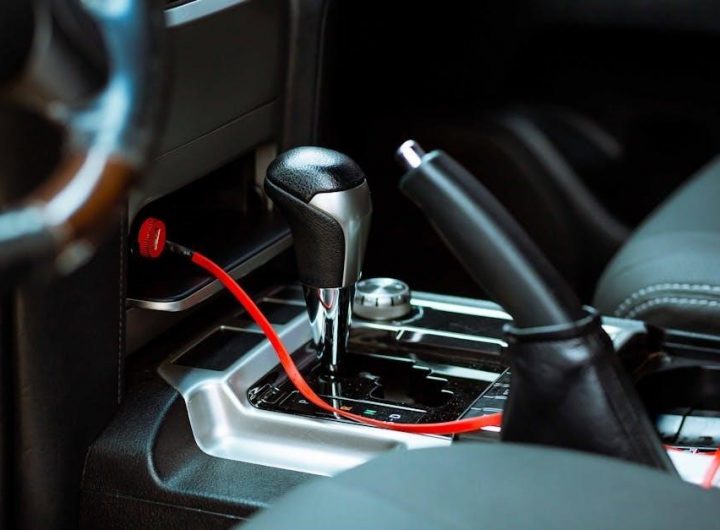 ford ranger manual gearbox
ford ranger manual gearbox  manual d calculation
manual d calculation  safety first grow and go manual
safety first grow and go manual  gm three speed manual transmission
gm three speed manual transmission 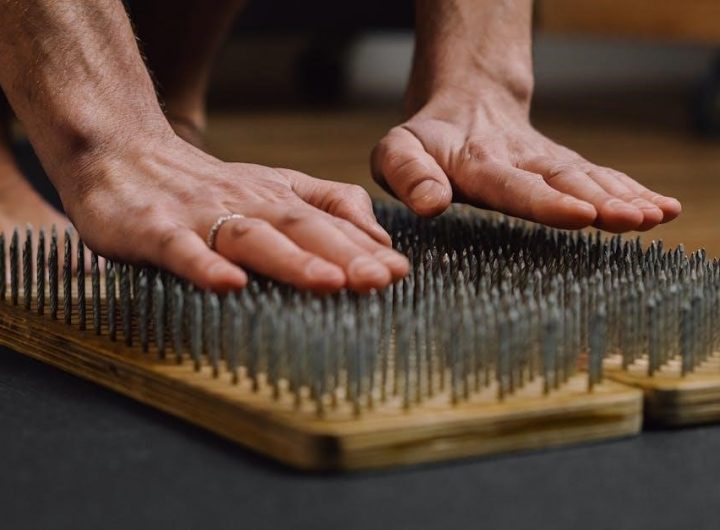 pressure cooker xl manual
pressure cooker xl manual  lippert electronic leveling manual
lippert electronic leveling manual  recovering from emotionally immature parents pdf
recovering from emotionally immature parents pdf  lego snowman instructions
lego snowman instructions  weber spirit 2 assembly instructions
weber spirit 2 assembly instructions  dtf care instructions
dtf care instructions